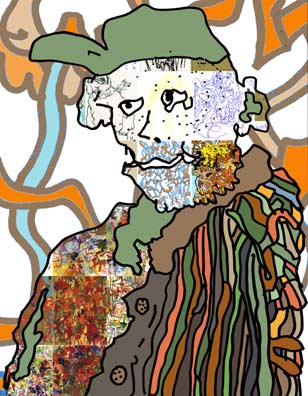
 |

"so, so very what"
Stephen Jay Gould, and his zoologist colleague, Dr. Richard Lewontin, once famously proposed that the architectural structure known as a spandrel is an apt metaphor to explain certain features of evolution. The notion of a spandrel, they suggest, is applicable to structures exhibited by an organism which appear to confer no adaptive benefit. The authors maintain that it is a fallacy to attribute a purpose to every structure an organism manifests.
In a seminal essay, they conclude that the cathedral builders of old, after satisfying the engineering required to construct a cathedral's arches and domes, were left with unavoidable but structurally nonessential spaces, eventually known as spandrels. (Flat wall space created between two adjacent arches is one example).
In biological terms, one especially flamboyant example of a spandrel would be the male peacock's tail. This is nonessential in the extreme. Its size, weight and lack of utility imperil the bird's well-being and survival. Yet, the glorious tails are not eliminated by selective pressure because peacock hens, presumably, get the hots only for the most extravagantly gorgeous plumage.
It would appear that Beauty is the strange attractor of peacock evolution. Viewed this way, the survival of the peacock is the story of a genome in service to Beauty as an end.
The cathedral builders of Europe filled their spandrels with mosaics, frescoes and sculpture. What if the cathedral were thought of as a mere container for said mosaics and frescoes? Viewed this way, the architecture of the cathedral becomes an ingeneous adaptation arrived at in order to provide an opportunity for art to thrive. Beauty is the strange attractor.
The modern age might well turn out to be the artistic equivalent of the Cambrian Explosion - that era of volatile expansion about which Gould so lovingly wrote in his book, "Wonderful Life." Maybe the eruption of various innovative artistic practices in the 20th century - the avante garde, technological innovation, populism - parallel, in our own way, that grand epoch when Mother Nature was furiously at work creating the torrent of experimental forms which (530 million years later) would give us this world enriched with peacocks, cathedrals and theoretically-inclined biologists.
Art rises to fill the non-essential with Beauty and in so doing eliminates the very notion of irrelevance.
There are ripening spandrels aplenty in the artistic practice of our time: neo-paganism, virtual community and sustainablity. The selective pressures of environmental stress, commerce and mediated lcd (lowest common denominator) are accute. Yet, Beauty as guiding imperative remains unassailable.
Posted by mark at December 23, 2003 11:51 PM